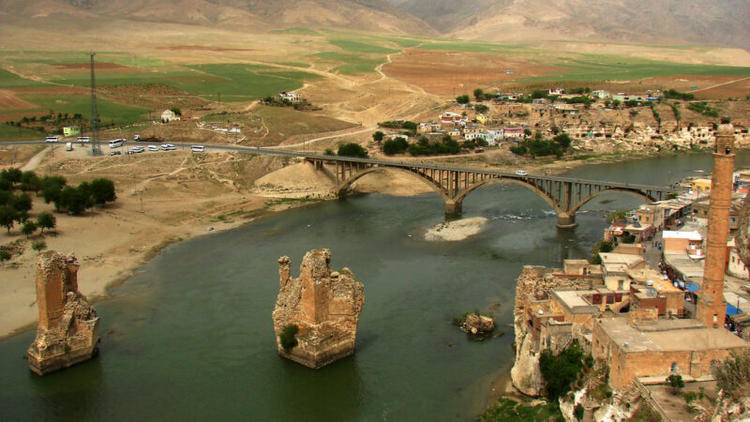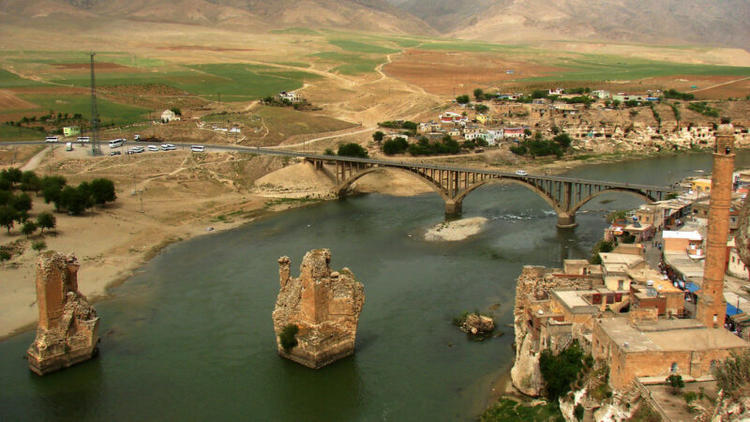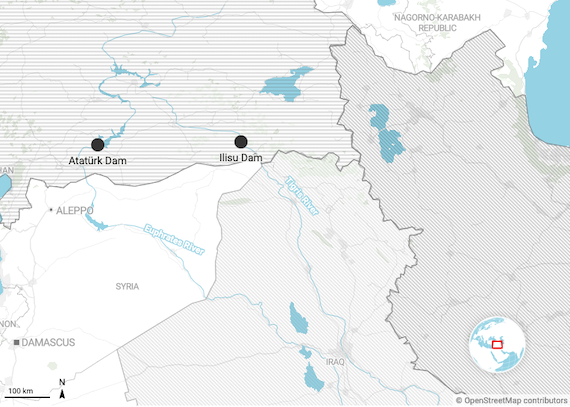By Roman Shemakov | –
The following story is part of series on Turkey’s Ilisu Dam project and the flooding of Hasankeyf.
The Ilisu Dam, completed as part of Turkey’s Güneydoğu Anadolu Projesi (Southeastern Anatolian Development Project or GAP for short in Turkish) in 2019, has faced heavy criticism from both local as well as international observers and downstream countries on the Tigris. Standing at 135 meters high and with total water storage of 10.6 billion cubic meters, the Ilisu Dam is the second largest within Turkey, after Atatürk Dam, and is the world’s largest when measured by filling volume among “concrete faced rockfill dams.”
A 2008 picture of the now-flooded Hasankeyf by Senol Demir via CC BY 2.0
The dam was first envisioned more than 70 years ago. But funding concerns and international pressure delayed its construction. In an interview with Global Voices, journalist Mehmet Kizmaz explained that when the construction of Ilisu Dam was decided in 2006, several earlier backers of the construction pulled out their export credit guarantees after realizing the environmental, cultural, and historical damage the construction would cause to the local residents.
By 2008, European companies that were part of the funding consortium transferred their shares to an Austrian company Andritz, which remained in the project throughout the planning and building stages. In 2010, with loans from mostly Turkish banks backed by the Turkish government, the construction finally began. Korkmaz added that at the start of planning, the estimated cost of the dam was at least EUR 2.5 billion, of which EUR 800 million was spent on expropriation and “resettlement” works. Kizmaz continued:
The actual costs are thought to be higher. Spending such a large amount of money on a devastating project that has brought nothing but poverty left the region that was already lagging economically, even poorer.
The dam became operational in 2019. However, in the process of creating a water storage reservoir, the 12,000-year-old city of Hasankeyf was flooded. At the time, the Turkish government emphasized that 1,200-megawatt (MW) power capacity would produce 4.1 billion kWh of electricity per year (approximately TRY 3 billion in annual revenue — USD 300 million). The expected energy, irrigation, and tourism income were used to justify the flooding of the ancient city and the relocation of the city residents.
Map: Global Voices Created with Datawrapper
It is still difficult to estimate the dam’s economic impact on the region. In 2014, the MP from Hakkâri noted the skewed impact of development, explaining that the “land values in some cities were intentionally expanded through planning and zoning. This is an intentional state policy, the introduction of wild capitalism into the region. This is a skewed development policy and social engineering, an attempt to shape a new identity.” On balance, the Ilisu Dam did not reduce inequality, “the project allowed 61.4 percent of small agricultural enterprises to cultivate only 10.5 percent of the land, while 6.2 percent of large agricultural enterprises cultivated almost half of the land.”
While the economic benefits of the dam are still unclear, the ecological and social damage remain front and center for residents in the area. Ridvan Ayhan, a resident and activist from Hasankeyf who spoke to Global Voices, said people lost their vineyards, gardens, land, and homes as they all got flooded. “Some 80,000–100,000 people had to migrate,” explained Ayhan, adding, “there is no future without a past, they destroyed our history, our culture, this history is not only ours, it is the history of humanity, this is a historical massacre.”
The flooding of the historical city of Hasankeyf has been at the heart of the organized opposition to the dam. Among the most vocal opponents is Ismail Can, the head of excavation at Karahan Tepe, one of Turkey’s oldest archeological sites, who spoke to Global Voices about the extent of destruction:
Since the world has existed, mankind has constantly worked to leave a mark on this world wherever it has lived. They have left behind magnificent structures that represent them, and unfortunately, we are not even aware of what kind of humanity we have destroyed. Hasankeyf has hosted dozens of civilizations. All of this we have now destroyed for the sake of a dam. It is impossible to compare the cultural heritage of thousands year old Hasankeyf, one of the main cradles of human civilization, with some income from the Ilisu Dam Hydroelectric Power Plant.
GAP’s international consequences
The Ilisu Dam doesn’t just impact the citizens of Turkey.
In 2002, a delegation of three UK nongovernmental organizations — The Ilisu Dam Campaign, the Kurdish Human Rights Project, and the Corner House — released a report on the potential downstream effects of the dams. According to the report, “The GAP dams have already caused significant change in the flow regime of the Euphrates and to a lesser extent the Tigris, both in terms of quality and quantity. The reduced flow of the Euphrates has already caused increased salinity in the lower reaches of the river, seriously affecting agriculture, and the full implementation of GAP would have major adverse consequences for large numbers of people living in [Syria and Iraq]” and that “Turkey is in violation of the letter or spirit of, or is failing to comply with… International conventions on water sharing and use, in particular the UN convention on the law of Non-Navigable Uses of International Watercourses.”
The governments of Iraq and Iran, whose people heavily rely on the Tigris River, have vocally opposed GAP and the Ilisu Dam. In 2018, Iraqi Prime Minister Haidar al-Abadi accused the Turkish government of abusing the Ilisu Dam for political reasons, Iraqi officials noted that dams along dozens of tributaries have cut more than half the water that flowed to Iraq compared with 20 years ago. The Iranian Foreign Minister Hossein Amir-Abdollahian has long criticized Turkey’s hydrology projects, in May of 2022 calling them “unacceptable,” and extremely damaging to the citizens of Iran.
An Iranian Change.org petition to stop Turkey from constructing more dams.
Considering that more than 50 percent of all regional water sources are shared between more than one country, Mehmet Kizmaz concluded with the oversized implications of the GAP projects internationally, “the Ilisu Dam had a very negative impact on the downstream of the Tigris River; Serious problems arose in the supply of drinking water in many Iraqi cities, especially Baghdad and Mosul. Iraqi agriculture, which was largely based on irrigation from rivers, came under great risk too. The Iranian environmental organizations announced that the Ilisu Dam Project, would accelerate environmental issues and exacerbate the dust clouds formed by the drying up of the Mesopotamian Marshes (Ahwar), which will be destroyed by the Ilisu Dam.”
Local and international resistance to future Turkish river development remains limited. A Change.org petition has been started by Iranian activists in order to prevent further hydroelectric development that are responsible for droughts throughout Iran. Years of protests in Southern Iraq have similarly accused Turkish dams of worsening water scarcity concerns. Kizmaz concluded that locally “there is no reaction in Hasankeyf at the moment. Because people rightly think that everything is over. Because of this, everyone was silent. This also applies to other people, especially activists and journalists, who have been fighting for years. I also have this feeling. Is there any chance of bringing the dead back to life?”
Roman Shemakov is Eastern Europe Editor of Globalvoices.org.





 © 2025 All Rights Reserved
© 2025 All Rights Reserved